Ores and by products - Study guides, Study notes & Summaries
Looking for the best study guides, study notes and summaries about Ores and by products? On this page you'll find 45 study documents about Ores and by products.
Page 3 out of 45 results
Sort by
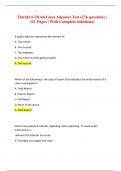
-
Florida 6-20 All Lines Adjuster Test (276 questions 111 Pages With Complete Solutions)
- Exam (elaborations) • 111 pages • 2023
-
- R242,37
- + learn more
that indicates the initial results of a claim investigation? A. Field Report B. Interim Report C. Full Report D. None of the above A. Field Report States have adopted statutes regarding claims adjusting. To avoid unfair treatment to a claimant the adjuster must not: A. Promptly investigate the claim. B. Follow the laws regarding the number of days in which to commence an investigation. C. Deny the claim until a fair and prompt investigation has commenced. D. Pay the claim within a reasonable num...
![AQA GCSE CHEMISTRY 8462/2H Paper 2 Higher Tier Question Paper + Mark scheme [MERGED] June 2022 *jUN2284622H01* IB/M/Jun22/E9 8462/2H For Examiner’s Use Question Mark 1](/docpics/2793289/646d082799f83_2793289_121_171.jpeg)
-
AQA GCSE CHEMISTRY 8462/2H Paper 2 Higher Tier Question Paper + Mark scheme [MERGED] June 2022 *jUN2284622H01* IB/M/Jun22/E9 8462/2H For Examiner’s Use Question Mark 1
- Exam (elaborations) • 68 pages • 2023
- Available in package deal
-
- R149,08
- + learn more
AQA GCSE CHEMISTRY 8462/2H Paper 2 Higher Tier Question Paper + Mark scheme [MERGED] June 2022 *jUNH01* IB/M/Jun22/E9 8462/2H For Examiner’s Use Question Mark 1 2 3 4 5 6 7 8 TOTAL Time allowed: 1 hour 45 minutes Materials For this paper you must have: • a ruler • a scientific calculator • the periodic table (enclosed). Instructions • Use black ink or black ball-point pen. • Pencil should only be used for drawing. • Fill in the boxes at the top of t...
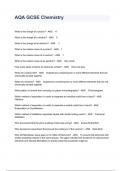
-
AQA GCSE Chemistry
- Exam (elaborations) • 19 pages • 2023
- Available in package deal
-
- R214,38
- + learn more
AQA GCSE Chemistry What is the charge of a proton? - ANS +1 What is the charge of a neutron? - ANS 0 What is the charge of an electron? - ANS -1 What is the relative mass of a proton? - ANS 1 What is the relative mass of a neutron? - ANS 1 What is the relative mass of an electron? - ANS Very small How many types of atoms do elements contain? - ANS Only one type What are compounds? - ANS Substances containing two or more different elements that...
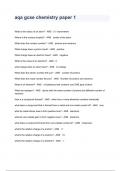
-
aqa gcse chemistry paper 1
- Exam (elaborations) • 16 pages • 2023
- Available in package deal
-
- R195,72
- + learn more
aqa gcse chemistry paper 1 What is the radius of an atom? - ANS 0.1 nanometers Where is the nucleus located? - ANS center of the atom What does the nucleus contain? - ANS protons and neutrons What charge does a proton have? - ANS positive What charge does an electron have? - ANS negative What is the mass of an electron? - ANS 0 what charge does an atom have? - ANS no charge What does the atomic number tell you? - ANS number of protons What does the...
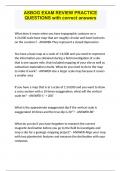
-
ASBOG EXAM REVIEW PRACTICE QUESTIONS with correct answers.
- Exam (elaborations) • 26 pages • 2024
-
- R149,08
- + learn more
What does it mean when you have topographic contours on a 1:24,000 scale base map that are roughly circular and have hachures on the counters? - ANSWER-They represent a closed depression You have a base map at a scale of 1:6,000 and you need to represent the information you obtained during a field investigation of a site that is one square mile, that included mapping of your site as well as subsurface exploration results. What do you need to do to the map to make it work? - ANSWER-Use a large...
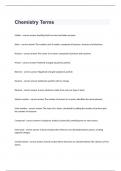
-
IGCSE Chemistry Complete Question And Answers 100% Correct.
- Exam (elaborations) • 3 pages • 2024
- Available in package deal
-
- R279,69
- + learn more
State the method used to obtain sand from a mixture of sand and water - correct answer filtration State the method used to obtain solid copper sulfate from aqueous copper sulfate - correct answer crystallisation State the method used to obtain red food dye from a mixture of food dyes - correct answer paper chromatography State the method used to obtain water from salt water - correct answer simple distillation Draw a diagram to show equipment used in simple distillation - correct ans...
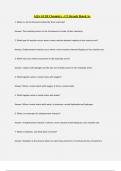
-
AQA GCSE Chemistry - C5 Already Rated A+
- Exam (elaborations) • 4 pages • 2024
- Available in package deal
-
- R179,88
- + learn more
AQA GCSE Chemistry - C5 Already Rated A+ 1. What is a list of elements ordered by their reactivity? Answer: The reactivity series is a list of elements in order of their reactivity. 2. What type of reaction occurs when a more reactive element replaces a less reactive one? Answer: Displacement reactions occur when a more reactive element displaces a less reactive one. 3. Which two non-metals are present in the reactivity series? Answer: Carbon and hydrogen are the two non-metals prese...
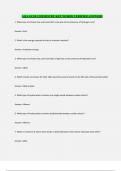
-
AQA GCSE CHEMISTRY KEY WORDS VERIFIED ANSWERS
- Exam (elaborations) • 9 pages • 2024
- Available in package deal
-
- R191,62
- + learn more
AQA GCSE CHEMISTRY KEY WORDS VERIFIED ANSWERS 1. What type of solution has a pH level that is low due to the presence of hydrogen ions? Answer: Acid. 2. What is the energy required to start a chemical reaction? Answer: Activation energy. 3. What type of solution has a pH level that is high due to the presence of hydroxide ions? Answer: Alkali. 4. Which metals are known for their high reactivity and are found on the left side of the periodic table? Answer: Alkali metals. 5. What...
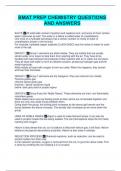
-
BMAT PREP CHEMISTRY QUESTIONS AND ANSWERS
- Exam (elaborations) • 8 pages • 2024
-
- R167,74
- + learn more
SALTS All solid salts consist of positive and negative ions, and some of them contain water molecules as well. The water in a lattice is called water of crystallisation. One mole of a hydrated salt always has a certain number of moles of water of crystallisation shown in the formula. For example, hydrated copper sulphate (CuSO4.5H2O) has five moles of water for each mole of the salt. GROUP 1 Group 1 elements are alkali metals. They are metals that are usually stored under oil or argon to stop t...

Did you know that on average a seller on Stuvia earns R4500 per month selling summaries? Hmm, hint, hint. Discover all about earning on Stuvia



